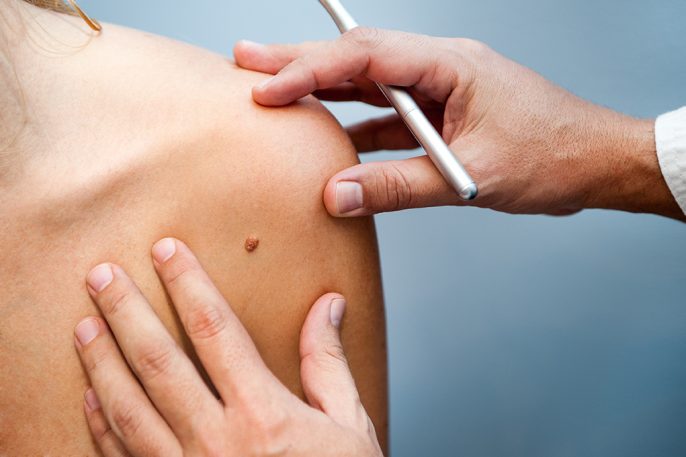7 Ways to Lessen Scarring After Skin Cancer Removal

Early detection and proper treatment of skin cancer are vital—and when it comes to removal, your doctor needs to be thorough to ensure all cancerous skin cells have been excised. It’s no wonder many patients feel anxious about possible scarring, particularly on the face. The good news is that techniques have improved, and there are a number of steps you can take to lessen scarring.
Here at Plastic Surgery Services, we have helped many skin cancer patients through the entire process. Frederick, Maryland plastic surgeon Dr. Garazo performs modified Mohs surgery to ensure thorough removal of cancerous cells and then applies his extensive plastic surgery knowledge to immediately (and attractively) reconstruct the area. Following are our best tips for preventing or lessening scarring after skin cancer removal.
Your doctor should use refined suturing and wound closure techniques to further minimize the appearance of scars. The care taken at this vital step in the process can have a large effect on your outcome.
1. Work with an experienced plastic surgeon
Board certified plastic surgeons spend many years studying and training in both reconstructive and cosmetic surgery techniques. This gives them a unique perspective, and they can combine functional and aesthetic techniques to provide optimal results.
Plastic surgeons like Dr. Garazo who are experienced in skin cancer removal and have spent decades providing cosmetically pleasing surgical results are particularly well qualified to minimize scarring.
2. Take advantage of the latest techniques and products to reduce scarring
When researching options for skin cancer removal, ask about modified Mohs surgery. As each layer of skin is removed, it is immediately examined for the presence of cancerous cells so the surgeon can ensure they have gone far enough to remove the entire lesion without causing excess damage. This method has more than a 98% cure rate and allows for more immediate reconstruction and healing. Once the cancerous cells have been removed, your plastic surgeon can use a skin flap or skin graft technique to close the affected area and stimulate healing.
Your doctor should use refined suturing and wound closure techniques to further minimize the appearance of scars. The care taken at this vital step in the process can have a large effect on your outcome!
The process doesn’t end with surgery; the right post-operative care is also essential. At our office, Dr. Garazo will recommend clinical-strength, medical-grade skincare products to enhance healing, help reduce the appearance of scars, and improve the overall health of your skin.
Aesthetic plastic surgeons have non-surgical treatment and product options that far surpass OTC products when it comes to treating scars, blemishes, and skin discoloration.
3. Keep scars out of the sun
While protecting your skin from the damaging rays of the sun is important for everyone, it’s even more crucial for skin cancer survivors—particularly in the early stages of scar formation. This is because UV rays can permanently darken scars.
Following surgery, take extra precautions to protect your skin. In addition to using a high SPF sunscreen, consider physically covering healing areas as much as is practical, especially when spending time outdoors.
4. Hydrate and moisturize
Drinking plenty of water helps to keep your skin and body hydrated, which promotes optimal healing, though topical moisture is also important. After your initial healing period (usually about two weeks), your plastic surgeon can instruct you how to massage the scar with an appropriate medical-grade cream to moisturize and soften scar tissue. You need to be gentle and avoid pulling, but massaging scars can promote blood flow to the area and assist with continued healing.
5. Be attentive to how you move
Stretching or straining your surgical site can put undue pressure on scars and cause them to be wider and more visible after healing. Be attentive and avoid twisting, bending, leaning on, or pulling areas where you had skin cancer removal. If your skin cancer repair is in a very mobile area that you tend to strain, discuss it with your surgeon and make plans to adapt your movements ahead of time.
6. Avoid harsh products
It’s important to avoid harsh products, such as lightening treatments, until you are completely healed. In fact, we recommend reviewing all of your skincare with your doctor or nurse as some ingredients can impede healing while others are not recommended for use on tender or broken skin. The good news is that you may discover something better. Aesthetic plastic surgeons have non-surgical treatment and product options that far surpass OTC products when it comes to treating blemishes and skin discoloration.
7. Be patient
Remember that while you’ll look quite good after only a few weeks, it can take 12 to 18 months following surgery for scar healing to be truly complete. Continue going to follow-up appointments, adhere to any skin cancer scar treatment your surgeon recommended, and ask about any concerns that arise.
The last word? With proper care, you can minimize the appearance of any scars or damage post-skin cancer removal. If you are concerned that any moles or marks on your skin may be cancerous, Dr. Garazo would be happy to schedule a consultation and evaluation with you. He provides comprehensive skin cancer care, including modified Mohs surgery and reconstructive plastic surgery for aesthetically pleasing results.
Leave a Comment
